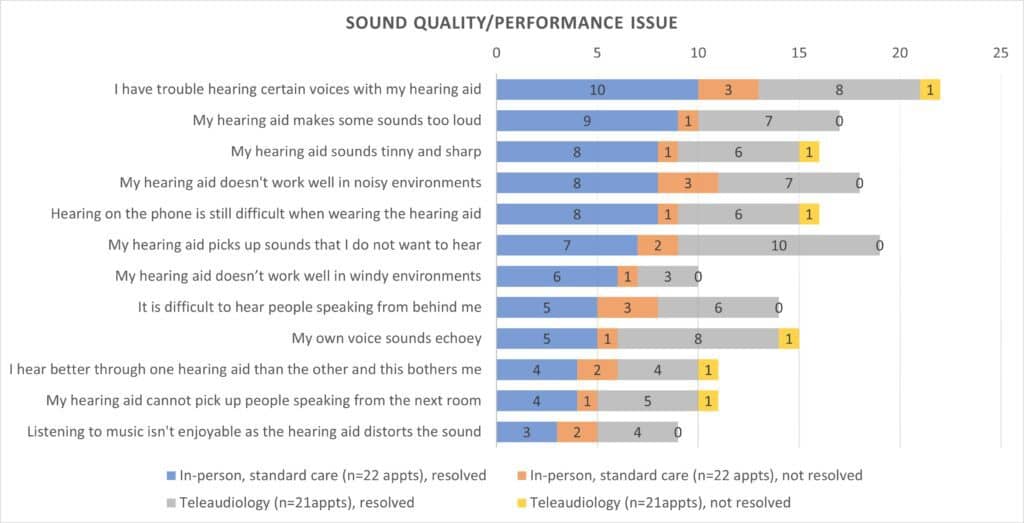Tech Topic | October 2022 Hearing Review
Teleaudiology can provide convenient and flexible post-fitting hearing health
By Barbra HB Timmer, PhD, and Lisa Dyre, AuD
Teleaudiology is seeing an upswing in interest and use these days due in part to the Covid-19 pandemic. Adoption has been further supported by the release of a host of resources such as toolkits and guidelines for professionals, apps and infrastructure by hearing device manufacturers, as well as current research findings on the subject. In fact, recent reviews by D’Onofrio and Zeng1 found that many diagnostic and rehabilitative audiology services can be effectively provided via teleaudiology. However, a recent study at The University of Queensland investigated not only effectiveness—outcomes comparing teleaudiology and in-person visits—but also looked at a more emotional factor, satisfaction. The results revealed a paradox: client outcomes and satisfaction ratings were equitable between appointment types. However, hearing care professionals were less satisfied providing the teleaudiology appointments. They were essentially asking, despite positive outcomes from the teleaudiology appointments, have I done my best for this patient?
Study Revelations
Addressing the question of outcomes and satisfaction for real-world post-fitting rehabilitative audiology appointments,2 the research team at The University of Queensland conducted a prospective cohort study and collaborated with various hearing care clinics that were newly implementing teleaudiology approaches in clinical practice. The study compared the audiological outcomes of 41 clients randomly allocated to receive post-fitting follow-up either by teleaudiology appointments via Phonak Remote Support, or standard in-person appointments. The study was also designed to gain insight into hearing care professional and client satisfaction and experience with teleaudiology (Table 1).

The results showed no significant differences 3 months post-fitting between teleaudiology versus in-person appointments in terms of self-reported hearing aid outcomes, communication ability, or hearing handicap, and in terms of objective hearing aid use data. Although there was a trend towards greater satisfaction with in-person appointments, the clients in the teleaudiology group reported only one significant difference when compared to the in-person appointments, on the item “I could clearly hear my clinician.” No other differences in measures comparing the client’s satisfaction with audiology services in the teleaudiology group to the standard care group were significant.
However, the hearing care professionals were less satisfied with the teleaudiology appointment outcomes than their clients. The 11 participating hearing care professionals with 6-to-30+ years of clinical experience reported being less satisfied with how their client received their hearing care services for clients in the teleaudiology group. Furthermore, the hearing care professionals reported feeling significantly less able to address the clients’ hearing care concerns during teleaudiology appointments. This concern was not evident when clients were asked if the hearing aid issues they raised during the appointment were resolved or not.
Resolution of hearing aid issues during teleaudiology and standard care appointments was measured by means of an online Audiology Appointment Satisfaction Scale, administered online for both clients and hearing care professionals after each appointment. The client version of the Scale also incorporated the hearing aid problems survey3 which lists 13 hearing aid management issues, and 13 sound quality or performance issues. After every follow-up appointment, each client was asked if the issue was discussed and if it could be resolved during the appointment. Clients in the in-person care group raised a total of 100 hearing aid management issues during 22 appointments, of which 77 (77%) could be resolved and 98 hearing aid sound quality and performance issues of which 77 (79%) could be resolved during the appointment. Clients in the teleaudiology group raised a total of 75 hearing aid management issues during 21 appointments of which 60 (80%) could be resolved and 80 hearing aid sound quality and performance issues of which 74 (93%) could be resolved during the appointment. Therefore, there was no significant difference in the number of issues that could be resolved during teleaudiology appointments compared to the standard care appointments.
The most common hearing aid management issues raised during both appointment types were not different and were: trouble inserting the hearing aid; trouble making program or volume changes on the hearing aid; and trouble using accessories such as remote controls (Figure 1). Similarly, the most common hearing aid sound quality and performance issues did not differ between the teleaudiology and standard care groups and were: trouble hearing certain voices; the hearing aid picking up unwanted sounds; the hearing aid not working well in noisy environments (Figure 2).


The hearing care professionals were also asked after each follow-up appointment to indicate which main issues or concerns they wanted to address during their client’s appointment. Answers to this question were given using open text responses and corresponded closely to the clients’ answers to the hearing aid problems survey.
What Does This Mean?
Teleaudiology appointments can effectively complement in-person standard hearing care. This research found that for the clients participating in this study, teleaudiology was an effective means of providing post-fitting follow-up care. The concerns raised by clients were not different from those raised during in-person appointments and could be equally resolved. Clients in the teleaudiology group also reported being as satisfied with the appointments as those in the in-person group. This study suggests that hearing care professionals can use teleaudiology approaches for hearing aid follow-up appointments for clients comfortable with the required technology, such as smartphones and applications.
But how do we as hearing care professionals embrace new modes of service delivery and feel satisfied that we have done our best? Certainly, for those interested in implementing or enhancing their teleaudiology services, there are a number of resources available. For example, to help hearing care professionals in the safe and effective delivery of hearing services through teleaudiology, Audiology Australia recently released the Australian Teleaudiology Guidelines. The recently released teleaudiology clinical guidelines and client resources can be found here: (https://teleaudiologyguidelines.org.au/teleaudiology-guidelines/.) A practical toolkit to setting up teleaudiology services can be found here: (https://idainstitute.com/tools/online_appointments_starter_kit/.)
And, resources for providing teleaudiology service to pediatric clients and families can be found here:(https://infanthearing.org/teleaudiology/index.html.)
To quote an old adage, “Practice makes perfect” and perhaps the solution for hearing care professionals’ satisfaction with teleaudiology is just that—practice. Embracing teleaudiology when it is appropriate, following guidelines, using outcomes measures to ensure effectiveness, and soliciting feedback from our clients to fine-tune our offered services perhaps can increase our satisfaction and confidence in providing teleaudiology services. Teleaudiology does not take away the need or delight of in-person visits for hearing health care. But in our increasingly digital world, teleaudiology can provide convenient and flexible access to hearing health services with equitable outcomes for those receiving post-fitting care.

Citation for this article: Timmer BHB, Dyre L. Teleaudiology and hearing aid care: Consumers are satisfied, why aren’t we? Hearing Review. 2022;29(3):20-22.
References
- D’Onofrio KL, Zeng F-G. Tele-audiology: Current state and future directions. Frontiers in Digital Health. 2022;3(788103):1-11.
- Timmer BHB, Waite M, Hickson L. Comparing audiological outcomes of teleaudiology and face-to-face hearing aid fitting follow-up consultations for adults with hearing impairment. Manuscript in preparation. 2022.
- Bennett RJ, Kosovich EM, Stegeman I, Ebrahimi-Madesih A, Tegg-Quinn S, Eikelboom RH. Investigating the prevalence and impact of device-related problems associated with hearing aid use. International Journal of Audiology. 2020;59(8):615-623.





